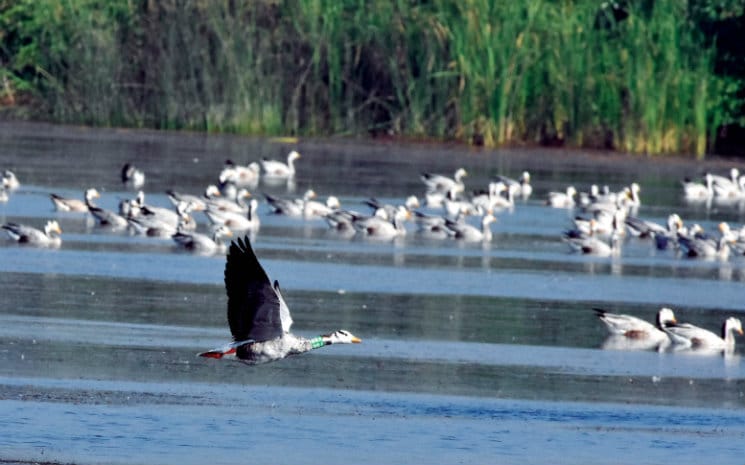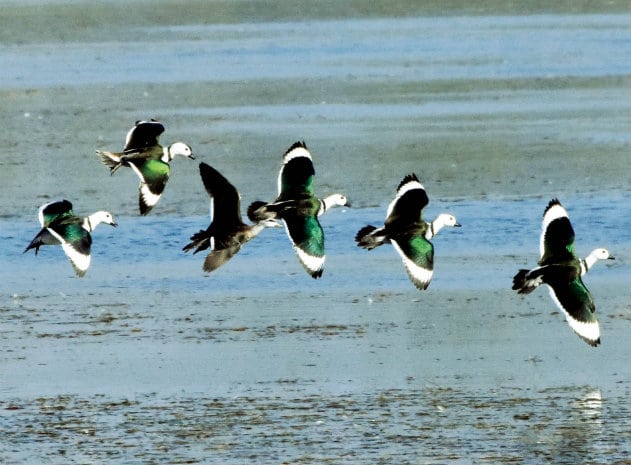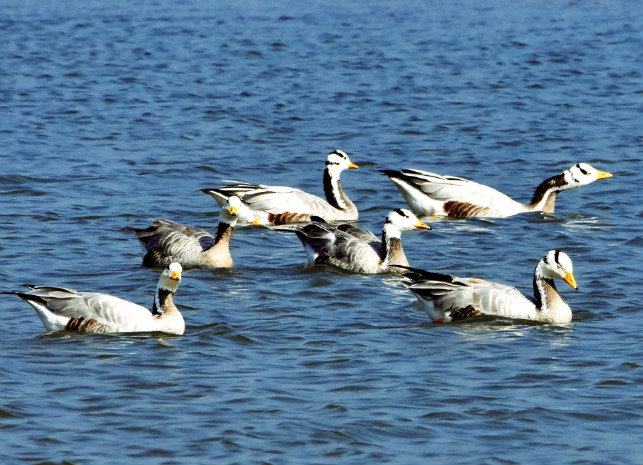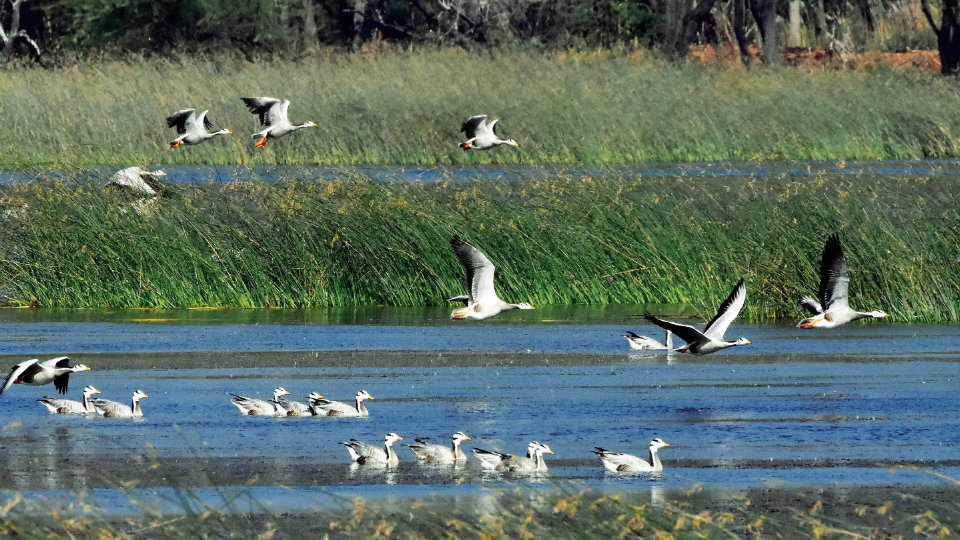- Migratory birds flock to Hadinaru Lake in Nanjangud for winter sojourn
- Geese with radio collars and identification tags also spotted
By Ravishankar
Nanjangud, Feb. 26- Even as winter season is through, birds from Mongolia have winged into the water body at Hadinaru Lake on the Mysuru-Nanjangud border, cheering bird-lovers and giving a strong indication that water bodies in Mysuru region are healthy.
The Bar-Headed Geese from Mongolia fly over the Himalayan Mountains and come to roost in different parts of the State after a brief sojourn in the central Indian plains. The wetlands and marshy habitats in the Northern parts of Karnataka, Mandya and Kolar and Mysuru-Chamarajanagar belt play host to birds during winter. Hadinaru Lake in Nanjangud taluk is a favourite among the Bar-Headed Geese.
With the arrival of migratory birds, the sprawling Lake, which is around 25 km from Mysuru city, located near the perennial Kabini River in Nanjangud, has turned into a bird-watchers’ pilgrim centre. The Lake is located near Chikkayyana Chatra Hobli in Nanjangud taluk and these birds can be easily distinguished from other geese by the black bars on their heads and their call is a typical goose honking.

Crossing the mountains
Every year, these migratory birds which are one of the world’s highest flying birds across the Himalayas, travel around 4,850 km to reach Hadinaru Lake during the winter. As the days are shorter and nights longer during winter in the Northern hemisphere, migratory birds find it difficult to find food in this short period in the brief days, and migrate to India by crossing the mountains.
Bar-Headed Geese (Anser indicus) is one of the world’s highest flying birds (27,000 feet). They fly higher than the Mount Everest when they migrate over the Himalayas from Mongolia, Kazakhstan and Russia towards South Asia, as far South as peninsular India. As the winter weather in Mongolia, Kazakhstan, and Russia becomes colder, as low as 10 degrees Centigrade, these migratory birds cross the Himalayan range to reach Southern part of Asia.

A friend of farmers
Bar-Headed Geese with radio collars and identification tags, tagged with neck-bands and numbered have also arrived with other geese to the lake for their wintering. These migratory birds which arrive in January or February nest here for around four months before they return to their homes up North. The birds only feed only on paddy grains, which are abundantly found in the area, especially as these birds arrive in the post-harvest season. They rest in the mornings and feed on grains in the fields during nights, so their droppings are good manure for the crops. The birds are friends of farmers, say bird-watchers.
Apart from migratory birds like the Bar- Headed Goose, birds like the Little Grebe, Cotton Pygmy Goose, Breasted Kingfisher, Purple Moorhen, Night Heron, Small Kingfisher, Greater Cormorant, Large and Little Egret, Common Coot, Spot Billed Duck, Painted Stork, Black Ibis, River Tern and others can also be found at the Lake.

Favourite spots for winter visitors
Hadinaru Kere is one of the favourite spots for these winter visitors. Locals call these birds as ‘Parvatakki’ in Kannada, which means mountain birds. These birds are crepuscular (late evening and dusk) in their foraging habit and feed on harvested rice crop stubble shoots adjoining the lakes they visit. They take daytime refuge in the midst of vast water bodies like lakes and reservoirs and doze off in the warm winter sun in the midst of lakes.
The Hadinaru Lake can be reached from the Mysuru-Nanjangud Road deviating near Tandavapura Industrial Area, or from Mysuru-Uttanahalli Road towards Hadinaru Road. Now it is the responsibility of every individual to protect them and appreciate their navigational abilities and physiological endurance needed for the 6,200 miles long journey.
[Pics by M.N. Lakshminarayana Yadav]








Lovely article and photos! Great to see so much interest in bird watching by youngsters in Mysore, thanks to the efforts of people like the writer and photographer of the article. The great Salim Ali (who I think surveyed the birds in this area in 1939-40) must be smiling (or verbalizing with an appropriate sound). I am reminded that some great scientists were attracted initially by ornithology and their fascination for birds. James D Watson (of DNA double helix fame) and the great German theoretical and evolutionary biologist and philosopher of biology, Ernst Mayr, were just two of them. How wonderful and amazing the natural world around us!
@Pai In those days of Mysuru, when the city boundaries were well defined and automobiles were not in plenty, the area near “Thandi Sadak road were rich in flora and fauna, and one could not see a single automobile. We used to go there on bicycles and enjoy the nature , which meant also watching of birds. The area mentioned in this article,: Mysore-Nanjangud road was favourite for our picnic and the lake mentioned and other lakes were attracting migratory birds during the Spring time. These lakes were pretty safe for Birds to dip in. One could also see the young princess: the ldaughters of the late Jayachamaraja Wadiyar, anchored near the lake presumably like us, to watch the migratory birds.
But, I wonder, how clean the lake mentioned is now, since there is an industrial estate nearby, and I suspect that this corridor is heavily used by automobiles which spew out toxic gases. The massive increase in the population of Mysuru, presents too its own environment hazards,
The moment these birds suspect the danger to their lives, they leave and go elsewhere. For them, a further 1500 miles is not a problem.
As for Watson and other life scientists, birds present unique opportunity to study, and ornithology is a wonderful side effect then. Watson, worked in the Cavendish Laboratory in Cambridge, England then. He must have lived in a nearby village. Even today, the Cambridge villages where the scientists live and cycle to work for 10-15 miles to go to their Laboratories in Cambridge, is an area for nature lovers. Watson , no doubt found its exhilarating to cultivate his interest as an ornithologist too.
@Pai If I may add further. For a long time, no one took much interest in Mangolia, the land of Genghis Khan. The presence of many national parks in his sparsely populated country started attracting visitors.
@ Jalandhara. Yes! Have heard from older citizens of Mysore about the wetlands all around Mysore teeming with flora, fauna and bird life. And remember reading that RK Narayan used to walk daily from his house (then in Laxmipuram in the earlier years?) to Kukarahalli lake. Believe also that the sky in Mysore in those days used to attract artists, just as the sky in the South of France attracted many of the great impressionist painters! Similarly, I used to ride on my bicycle out of the city to watch the sunset in the Madras of the early 70s. That area was a vast empty sea of waving grass. Now an urban jungle called Annanagar!
Yes, Mongolia! The great physicist Richard Feynman (of the Feynman diagrams in quantum mechanics and who taught the great “Feynman lectures in Physics” for many years in Caltech) practised “Mongolian throat singing” (probably inspired by birds?) and was keen on visiting the country. I am not sure if he made it. Sadly, saw a BBC program which said the capital of Mongolia is now one of the most polluted cities on earth because of the coal fires people burn to keep warm in the winters.
@Pai The painters like Van Gogh ( Dutch living in France) and Claude Monet -I have visited both their places and the nature nearby they painted were more interest in gentle nature. Other impressionist painters like Vermeer ( Dutch) and Italian impressionist painters placed humans at the centre. Turner and Constable were really the kind of landcape painters who would be interested in the above scene of migratory birds,and the landscape.
In early 1970s,I took 2courses taught by Richard Feynman ,andhe was an excellent Bongo drum player.
What I described in the Mysore-Nanjangud corridor wasin late 1960s,where we frequently had our day picinics.
@Jalandhara Constable! Love his painting “The hay Rick.” My grandfather had a similar print (don’t remember if of a painting or photograph) of an equivalent rural Indian scene with a Bullock resting and eating hay and a country cart. Loved to look at it. The industrial revolution in England from the 1750s onwards changed the relationship between man and nature and began our slide to unsustainable living. Oliver Goldsmith’s “The deserted village”, the novels of Thomas Hardy etc all deal with these tectonic shifts in our relationships with each other and with nature. There were some pluses, of course, but there was no thought to the common or greater good in these developments, only the supposedly benign and invisible hand of the market. The final nail in the coffin, of course, was the advent of Ford, the personal automobile and the mechanization of human beings in the assembly line (which Charlie Chaplin has so brilliantly parodied in his movies). I am no Luddite. I love the austere beauty of science, but there has been no vision in taking its lessons forward or thought to the kind of world we would like to create from it. Prometheus unbound was always going to be a mixed blessing. Your thoughts?
@Pai We are talking here about nature and probably its influence on humans.Hence, theMysuru-Nanjangud corridoris an important focal point,asthemigratory birds find their temporary abode here.
Ofcourse,Goldsmithan Irishman ,was a Londoner all his life,lies buried in a grave within the corridor of the legal inns of court ( ancient colleges,which offer legalstudies, in an atmosphere which has not changed since the medieval period) where he took uphis lodging. He wrote mainly about humans, and when nature intruded there, it was just a secondary issue. But Thmoas Hardy,who trained as an architect, but lived in rural England( Wessex)made nature as an equalpartner to humans, like he did in “Tess of the d’Urbervilles”, of Salisbury Plains,which has not changed, and never will.
The Dutch impressionist painters, who I suspect provided the enthusiasm for Hardy,were born in a land which even today has ,in my opinion, the best Kaleidoscopic nature scenaries. The windmills and the swaying tulips in green patches of land is a sight to be savoured. Hence,Dutch painters werethe best impressionists as they grew up in a land abound with nature mysteries. Automobiles have not destroyed the Dutch countryside. Constable would have produced many landscape canvasses had he visited New Zealand then which as a country was relatively unknown then. Tolkien’s Lord of the Ring trilogy is so enmeshed with what one sees in New Zealand by way of nature ( the Middle Earth), and yet he never visited that country. Peter Jackson so correctly guessed it,and hence made the films a run away success.
More than the USA,which is married to car culture, India is the worst imitator of this culture. There are still plains of Kansas and the wonderful rugged land in Wyoming providing breath-taking realisation that nature is worth preserving. But India,the imitator of the car culture is managing to destroy what is left of nature with galloping population increasing proving the hammer blow.This Mysuru-Najangud corridor will also see multiplelanes of highway in the near future. Even as a computer scientist and an engineer, I wish the technology slows down with slowing of materialism,in order tofocuson what is worth preserving.Otherwise,thiscountry willdestruct itself,trying to apethe West, where in many countries, there is ahealthy respect for nature. When we studied Kalidasa’s Meghaduta ( Sandesha)in Mysuru,the compact city then with its bountifulnature spots provided a good backdrop for that study. That was then , and the multiple lanes of highways is now.
FANTASTIC ARTICLE。